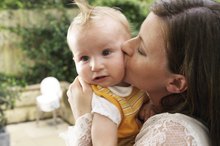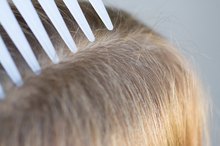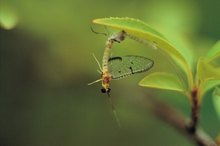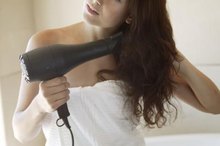What does fact checked mean?
At Healthfully, we strive to deliver objective content that is accurate and up-to-date. Our team periodically reviews articles in order to ensure content quality. The sources cited below consist of evidence from peer-reviewed journals, prominent medical organizations, academic associations, and government data.
The information contained on this site is for informational purposes only, and should not be used as a substitute for the advice of a professional health care provider. Please check with the appropriate physician regarding health questions and concerns. Although we strive to deliver accurate and up-to-date information, no guarantee to that effect is made.
Coconut Oil and Head Lice
The very thought of catching head lice makes most people’s heads itch, but they are more of a nuisance than an actual health threat. Treating head lice requires patience, attention and follow-through, but you don’t have to fumigate your home or shave your pets. If you want to avoid harsh chemicals and extreme measures, using lice shampoo containing coconut oil is a wise choice.
Head Lice
Head lice are tiny, wingless insects with little claws that allow them to cling to hair. Most North American head lice prefer round hair shafts, so African-Americans, who have oval hair shafts, are less likely to be affected. Adult lice are approximately the size of a sesame seed, and their eggs, called nits, are even smaller 1. This makes them extremely hard to to find. Adult lice, young lice -- called nymphs -- and nits can survive being smothered in mayonnaise or oil overnight and they can live under water for 14 hours 1.
Coconut Oil
How to Tell If the Nits Are Dead After a Treatment
Learn More
Most head lice shampoos that contain coconut oil also contain anise seed, ylang ylang and isopropyl alcohol. These shampoos have a very strong licorice scent due to the anise seed. The coconut oil kills the adult lice and the newly hatched nymphs, but not the eggs, so combing is still necessary. Shampooing and combing should be repeated a minimum of four times, with each shampoo being done three days apart.
- Most head lice shampoos that contain coconut oil also contain anise seed, ylang ylang and isopropyl alcohol.
- The coconut oil kills the adult lice and the newly hatched nymphs, but not the eggs, so combing is still necessary.
Procedure
Once you have shampooed the hair with a coconut oil shampoo, you must comb out the dead lice and nits. It is very difficult to kill the nits, so removing them from the hair is the only way to be sure that the infected person is free of lice. Use a fine-toothed metal nit comb, and go over the hair in sections, clipping each clean section up if you are dealing with long hair. Use a magnifying glass if necessary, and do not rush.
- Once you have shampooed the hair with a coconut oil shampoo, you must comb out the dead lice and nits.
- Use a fine-toothed metal nit comb, and go over the hair in sections, clipping each clean section up if you are dealing with long hair.
Pros and Cons
Lice and Dreadlocks
Learn More
Avoiding the use of harsh chemicals, especially on the heads of young children, pregnant women and anyone with severe allergies or a compromised immune system is always a wise choice. If you don’t get all of the nits out with a lice comb, the infestation will continue and keep spreading. Coconut oil alone is not enough to clear an infection; it must be used in conjunction with combing.
Related Articles
References
- University of California; Agriculture and Natural Resources; Head Lice management guide
- University of Nebraska - Lincoln; Managing head Lice Safely
- NYU Langone Medical Center; Head Lice; Jennifer Hellwig, MS, RD
- Centers for Disease Control and Prevention: Head Lice; Biology; November 2010
- Meister L, Ochsendorf F. Head Lice: Epidemiology, Biology, Diagnosis, and Treatment. Deutsches Ärzteblatt International. 2016;113(45):763-772. doi:10.3238/arztebl.2016.0763
- Centers for Disease Control and Prevention. Head Lice: Frequently Asked Questions (FAQs). Updated July 17, 2019.
- Devore CD, Schutze GE. Head Lice. Pediatrics. 2015;135(5). doi:10.1542/peds.2015-0746
- Barker SC, Altman PM. A Randomised, Assessor Blind, Parallel Group Comparative Efficacy Trial of Three Products for the Treatment of Head Lice in Children--Melaleuca Oil and Lavender Oil, Pyrethrins and Piperonyl Butoxide, and a "Suffocation" Product. BMC Dermatol. 2010 Aug 20;10:6. doi:10.1186/1471-5945-10-6
- Abdel-Ghaffar F, Al-Quraishy S, Al-Rasheid KA, Mehlhorn H. Efficacy of a Single Treatment of Head Lice With a Neem Seed Extract: An in Vivo and in Vitro Study on Nits and Motile Stages. Parasitol Res. Published June 11, 2011. doi:10.1007/s00436-011-2484-3
Writer Bio
Emmy-award nominated screenwriter Brynne Chandler is a single mother of three who divides her time between professional research and varied cooking, fitness and home & gardening enterprises. A running enthusiast who regularly participates in San Francisco's Bay to Breakers run, Chandler works as an independent caterer, preparing healthy, nutritious meals for Phoenix area residents.









